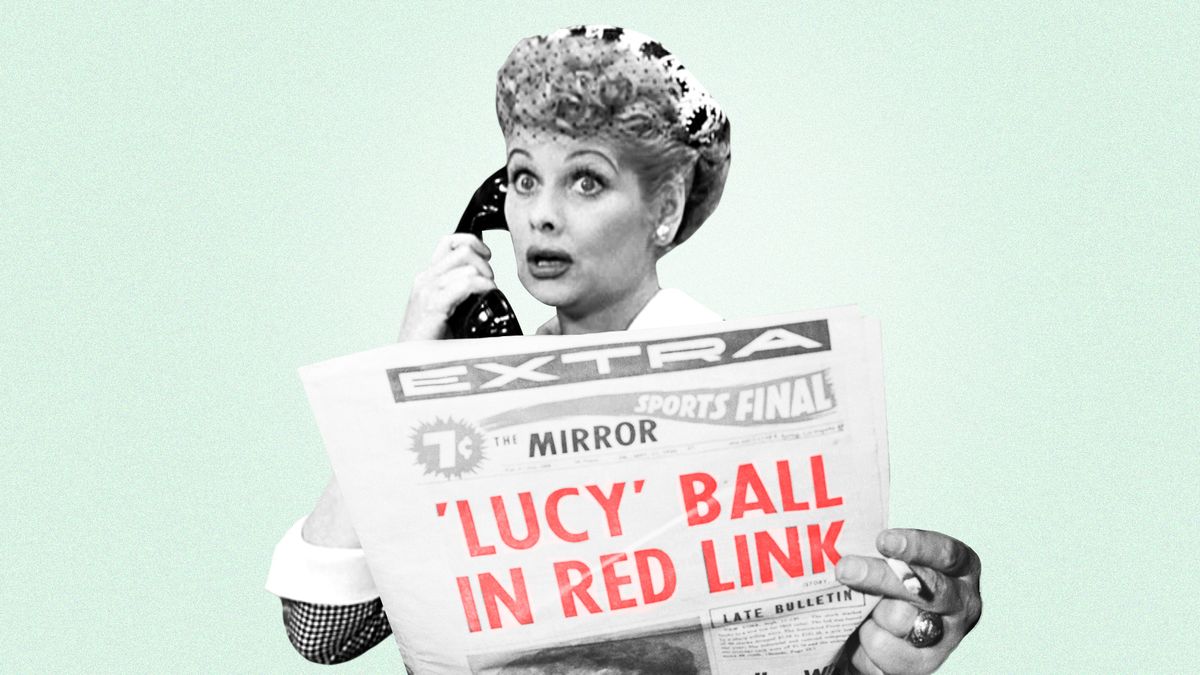Lucille Ball, a prominent figure in her prime, held immense power as one of America's most influential women.
Her television show, I Love Lucy, captivated audiences and garnered an impressive viewership of 15 million people each week, accounting for nearly 60% of American households.
Ball and her husband, Desi Arnaz, broke barriers on screen by showcasing a mixed-race marriage and even depicting a pregnant character.
These seemingly ordinary aspects of the show were groundbreaking moments in pop culture history.
However, there was one word that could have threatened Ball's success: Communist.
In 1953, during the height of the second Red Scare, prominent figures in Hollywood faced scrutiny if any suspicion arose regarding their ties to communism or sympathy towards the communist cause.
Ball found herself in a precarious situation when it was revealed that she had been associated with the Communist Party approximately 15 years prior.
This aspect of her life forms the basis of the film “Being the Ricardos,” which focuses on a tumultuous week in Ball's life rather than being a comprehensive biopic.
While the film takes creative liberties, the true story of Ball's encounter with communism is less dramatic but still posed a significant risk to everything she had built.
To understand the gravity of Ball's predicament, it is essential to comprehend the severity of the Red Scare in America.
Both waves of this period were marked by a fear of communism's influence in the country.
The first wave emerged after the Russian October Revolution following World War I and the American Labor Movement.
However, what people feared most was the idea that far-left and workers' rights groups were plotting to dismantle American democracy, which was not based on reality.
The second wave of the Red Scare began in the late 1940s and was characterized by McCarthyism, named after Senator Joseph McCarthy.
McCarthy employed fear-mongering tactics to expose communist sympathizers and activists in the United States.
He accused numerous individuals of promoting a socialist agenda within America.
Many prominent figures in the arts, including Dorothy Parker, Arthur Miller, W.E.B DuBois, Langston Hughes, Dalton Trumbo, Albert Einstein, and Lucille Ball, became embroiled in this controversy.
Ball's involvement can be traced back to 1936 when she registered to vote and affiliated herself with the Communist Party, alongside other members of her family.
She later claimed that she did so to fulfill her socialist grandfather's wishes but was never actively involved in the party.
However, Rena Vale, a Hollywood writer and Communist, testified before the House Un-American Activities Committee that she attended a new member class at Ball's residence in 1937, contradicting Ball's assertions.
In 1953, Ball voluntarily appeared before the House Un-American Activities Committee to clarify the situation.
She reiterated that she had only registered as a Communist to appease her grandfather and had never identified as one or voted in favor of communism.
Her testimony was then forwarded to J. Edgar Hoover, the FBI director at the time, who cleared her of any suspicions.
Nonetheless, the Los Angeles Herald-Express published a headline, “Lucille Ball Was Red in 1936,” which could have potentially damaged her career.
As I Love Lucy was filmed in front of a live studio audience, Arnaz, who often warmed up the crowd before shows, believed it was best to address the situation head-on.
Before shooting episode 68, “The Girls Go Into Business,” Arnaz reportedly reassured the audience by stating, “The only thing red about Lucy is her hair, and even that's not legitimate.”
Later that year, President Dwight D. Eisenhower invited Ball and the principal cast of I Love Lucy to celebrate his birthday in Washington, demonstrating that her reputation remained intact.
The film “Being the Ricardos” takes some creative liberties with the events.
For instance, it portrays the episode chronicling Ball's clash with the U.S. government as episode 22, “Fred and Ethel Fight.”
In reality, this episode was filmed before the actual scandal occurred.
However, due to its relevance within the larger narrative, which also touches on Arnaz's alleged infidelity, the film opted to change which episode was featured.
While the movie does not depict Ball's testimony before the House of Representatives, it hints at a discrepancy between what Ball told the government officials and what Arnaz wanted to convey to the public.
The couple argued over how to address the situation, with Arnaz suggesting they present it as a mere mistake in checking the wrong box during registration.
However, a newspaper image of Ball's voter registration card published in the Los Angeles Herald-Express clearly shows the word “Communist” written on the card rather than merely being checked off.
One notable deviation in the film occurs when Arnaz addresses the audience before the show.
In the movie, he engages a reliable source, J. Edgar Hoover, to confirm Ball's innocence by having a phone conversation broadcasted through the speaker system.
In reality, this never happened.
Nevertheless, Ball's reputation gradually recovered in the ensuing months, and she became known as an American treasure.
In conclusion, the true story behind the ‘Being the Ricardos' scandal reveals the challenges Lucille Ball faced during the Red Scare era.
While the film takes artistic liberties, it captures the essence of the controversy that threatened to undermine Ball's success.
Her encounter with communism may not have been as cinematic as portrayed, but it placed everything she had worked for at risk.
Ultimately, Ball emerged from the ordeal with her reputation intact, leaving behind a lasting legacy as an icon of American television.































